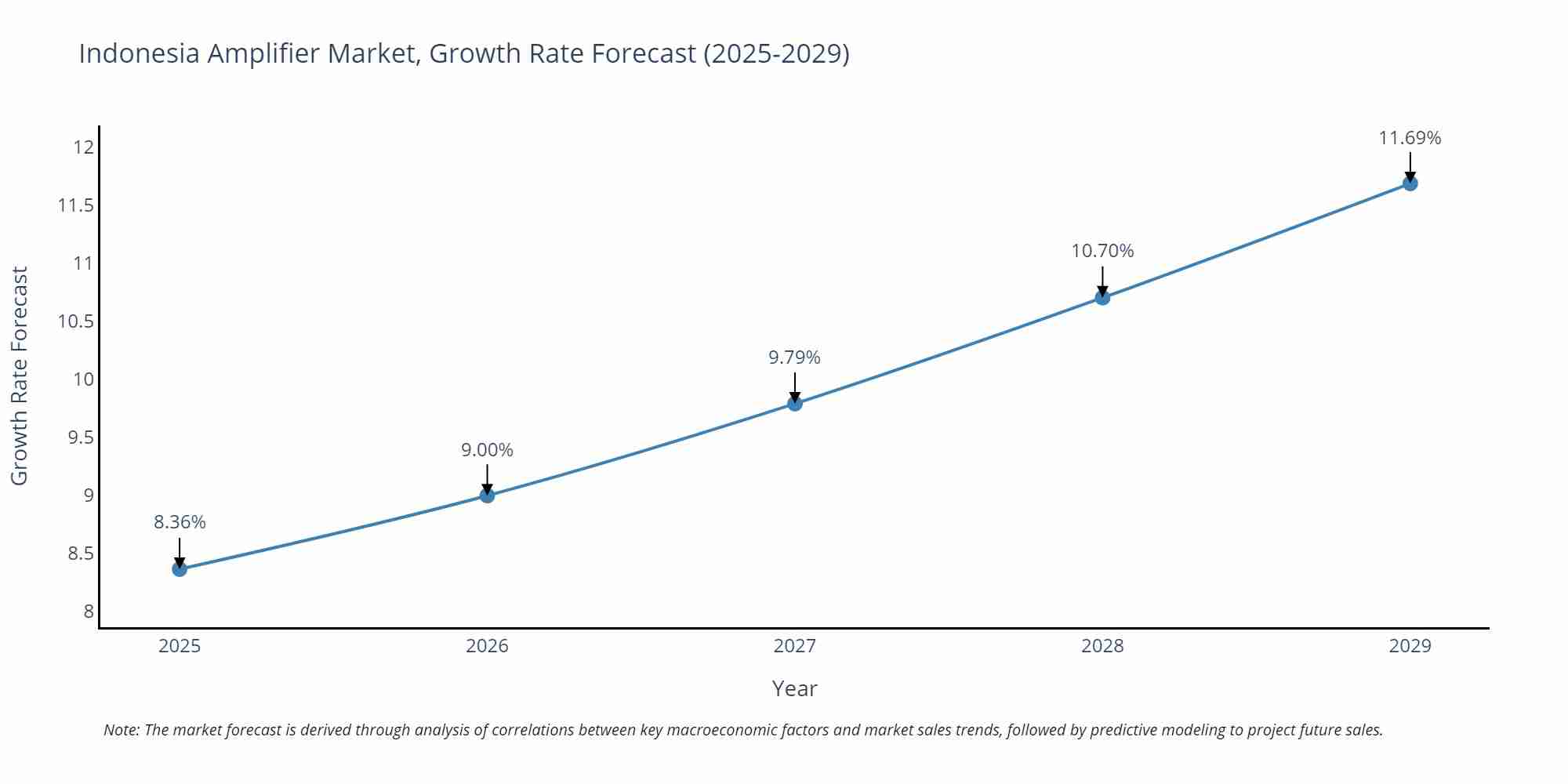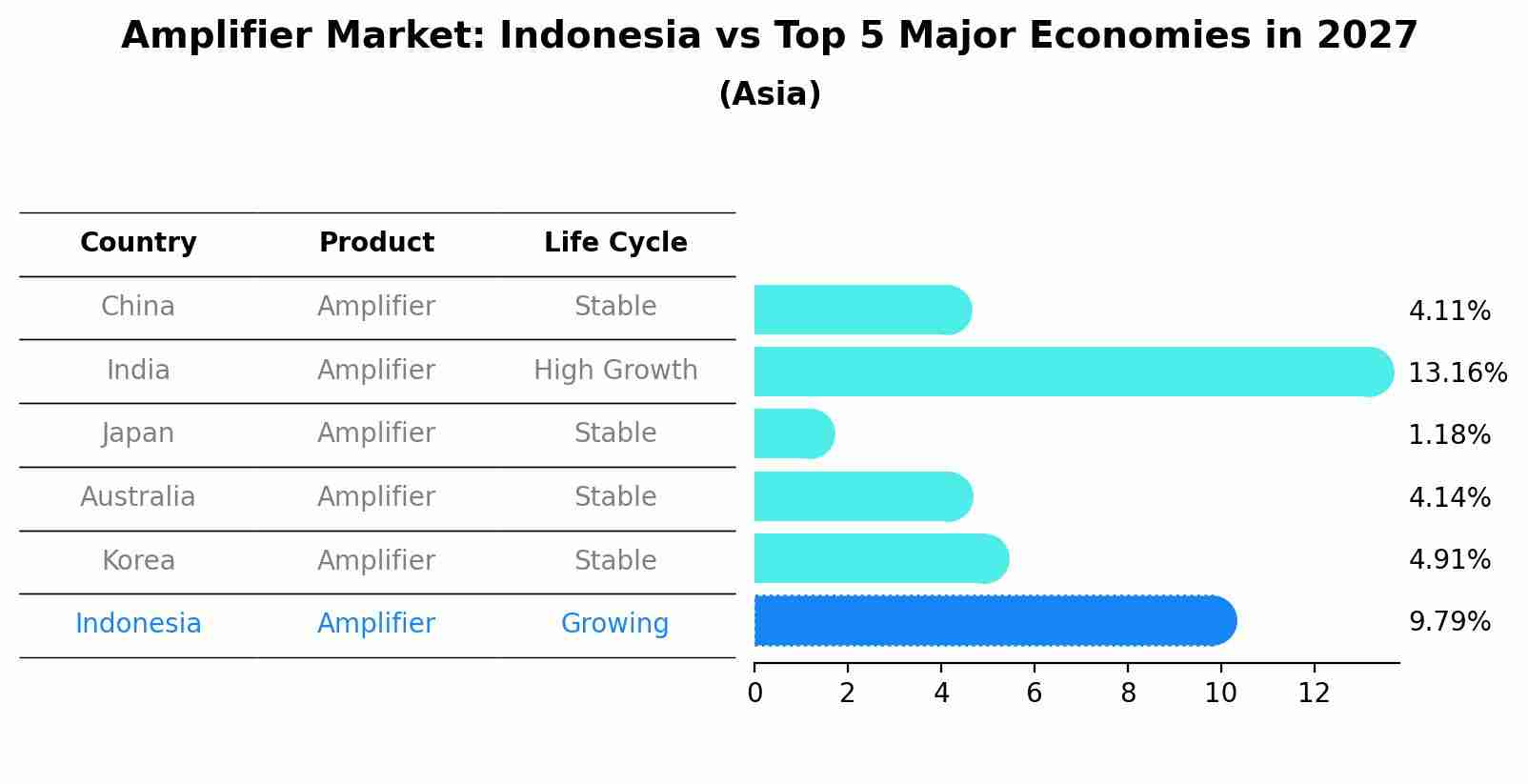Indonesia Amplifier Market (2024-2030) | Trends, Forecast, Analysis, Industry, Value, Outlook, Growth, Share, Size, Revenue & Companies
| Product Code: ETC028428 | Publication Date: Jul 2023 | Updated Date: Apr 2025 | Product Type: Report | |
| Publisher: 6Wresearch | No. of Pages: 70 | No. of Figures: 35 | No. of Tables: 5 | |
Indonesia Amplifier Market Size Growth Rate
The Indonesia Amplifier Market is likely to experience consistent growth rate gains over the period 2025 to 2029. The growth rate starts at 8.36% in 2025 and reaches 11.69% by 2029.

Amplifier Market: Indonesia vs Top 5 Major Economies in 2027 (Asia)
The Amplifier market in Indonesia is projected to grow at a growing growth rate of 9.79% by 2027, highlighting the country's increasing focus on advanced technologies within the Asia region, where China holds the dominant position, followed closely by India, Japan, Australia and South Korea, shaping overall regional demand.

Indonesia Amplifier Market Synopsis
The Indonesia amplifier market is expected to witness significantover theperiod of 2020-2026 owing to the increasing demand for consumer electronics and increased spending power. Indonesia favorable economic policies and easy access to financing are likely to drive the market further. In addition developments in amplifier technology such as digital signal processing (DSP) will create opportunities for manufacturers in this .
Key Factors Driving the Market
The rising demand for electronic devices such as smartphones tablets and laptop PCs has fueled theof the amplifier market in Indonesia. This trend is expected to continue in the coming years due to an increase in disposable incomes coupled with improved living standards across various regions of Indonesia. The Indonesia government provides various incentives that make it easier forinvesting or operating there to obtain financial assistance from lenders at competitive rates which will help them expand their operations more easily and at a lower cost than before thus driving up sales of amplifiers significantly during theperiod.Recent advancements such as digital signal processing (DSP) better audio compression algorithms and high-efficiency designs have enabled manufacturers offering amplifiers tailored specifically toward different applications like home theater systems or mobile devices like smartphones or tablets among others resulting into higher adoption rate across end user segments leading towards greater number of orders placed by distributors regionally further boosting held by manufactures operating within realm same domain thereby augmenting overall regional expansion rate along with associated profits generated during same time frame.
Challenges Facing the Market
One challenge faced by players in thisis related to high component costs which makes it difficult for them to keep prices low while maintaining quality levels demanded by customers creating pricing pressure leading towards lesser profit margins holding back new entrants/investors from entering into business space altogether restricting regional development rate associated profitability ratio consequently hindering its overall commercialization graph over specified timeline period. Another major issue facing players within domain lies under umbrella term of lack awareness about respective products offered alongside limited reach maintained by distributors offering aforementioned goods hampering capability amongst users belonging towards smaller townships situated across country side curtailing product acceptance from international audience base drastically reducing chances pertaining entrance onto global stage on part these manufactures ultimately resulting into shrinking customer poollimiting amplified s accrued through sales process carried out.
Key Highlights of the Report:
- Indonesia Amplifier Market Outlook
- Market Size of Indonesia Amplifier Market, 2023
- Forecast of Indonesia Amplifier Market, 2030
- Historical Data and Forecast of Indonesia Amplifier Revenues & Volume for the Period 2020-2030
- Indonesia Amplifier Market Trend Evolution
- Indonesia Amplifier Market Drivers and Challenges
- Indonesia Amplifier Price Trends
- Indonesia Amplifier Porter's Five Forces
- Indonesia Amplifier Industry Life Cycle
- Historical Data and Forecast of Indonesia Amplifier Market Revenues & Volume By Type for the Period 2020-2030
- Historical Data and Forecast of Indonesia Amplifier Market Revenues & Volume By Class-A for the Period 2020-2030
- Historical Data and Forecast of Indonesia Amplifier Market Revenues & Volume By Class-B for the Period 2020-2030
- Historical Data and Forecast of Indonesia Amplifier Market Revenues & Volume By Class-A/B for the Period 2020-2030
- Historical Data and Forecast of Indonesia Amplifier Market Revenues & Volume By Class-G&H for the Period 2020-2030
- Historical Data and Forecast of Indonesia Amplifier Market Revenues & Volume By Class-D for the Period 2020-2030
- Historical Data and Forecast of Indonesia Amplifier Market Revenues & Volume By ???l???t??n for the Period 2020-2030
- Historical Data and Forecast of Indonesia Amplifier Market Revenues & Volume By ??n?um?r ?ud?? for the Period 2020-2030
- Historical Data and Forecast of Indonesia Amplifier Market Revenues & Volume By ?ut?m?t?v? ?ud?? for the Period 2020-2030
- Historical Data and Forecast of Indonesia Amplifier Market Revenues & Volume By ??m?ut?r ?ud?? for the Period 2020-2030
- Historical Data and Forecast of Indonesia Amplifier Market Revenues & Volume By ?nt?r?r??? ?ud?? for the Period 2020-2030
- Indonesia Amplifier Import Export Trade Statistics
- Market Opportunity Assessment By Type
- Market Opportunity Assessment By ???l???t??n
- Indonesia Amplifier Top Companies Market Share
- Indonesia Amplifier Competitive Benchmarking By Technical and Operational Parameters
- Indonesia Amplifier Company Profiles
- Indonesia Amplifier Key Strategic Recommendations
Frequently Asked Questions About the Market Study (FAQs):
1 Executive Summary |
2 Introduction |
2.1 Key Highlights of the Report |
2.2 Report Description |
2.3 Market Scope & Segmentation |
2.4 Research Methodology |
2.5 Assumptions |
3 Indonesia Amplifier Market Overview |
3.1 Indonesia Country Macro Economic Indicators |
3.2 Indonesia Amplifier Market Revenues & Volume, 2020 & 2030F |
3.3 Indonesia Amplifier Market - Industry Life Cycle |
3.4 Indonesia Amplifier Market - Porter's Five Forces |
3.5 Indonesia Amplifier Market Revenues & Volume Share, By Type, 2020 & 2030F |
3.6 Indonesia Amplifier Market Revenues & Volume Share, By ???l???t??n, 2020 & 2030F |
4 Indonesia Amplifier Market Dynamics |
4.1 Impact Analysis |
4.2 Market Drivers |
4.3 Market Restraints |
5 Indonesia Amplifier Market Trends |
6 Indonesia Amplifier Market, By Types |
6.1 Indonesia Amplifier Market, By Type |
6.1.1 Overview and Analysis |
6.1.2 Indonesia Amplifier Market Revenues & Volume, By Type, 2020-2030F |
6.1.3 Indonesia Amplifier Market Revenues & Volume, By Class-A, 2020-2030F |
6.1.4 Indonesia Amplifier Market Revenues & Volume, By Class-B, 2020-2030F |
6.1.5 Indonesia Amplifier Market Revenues & Volume, By Class-A/B, 2020-2030F |
6.1.6 Indonesia Amplifier Market Revenues & Volume, By Class-G&H, 2020-2030F |
6.1.7 Indonesia Amplifier Market Revenues & Volume, By Class-D, 2020-2030F |
6.2 Indonesia Amplifier Market, By ???l???t??n |
6.2.1 Overview and Analysis |
6.2.2 Indonesia Amplifier Market Revenues & Volume, By ??n?um?r ?ud??, 2020-2030F |
6.2.3 Indonesia Amplifier Market Revenues & Volume, By ?ut?m?t?v? ?ud??, 2020-2030F |
6.2.4 Indonesia Amplifier Market Revenues & Volume, By ??m?ut?r ?ud??, 2020-2030F |
6.2.5 Indonesia Amplifier Market Revenues & Volume, By ?nt?r?r??? ?ud??, 2020-2030F |
7 Indonesia Amplifier Market Import-Export Trade Statistics |
7.1 Indonesia Amplifier Market Export to Major Countries |
7.2 Indonesia Amplifier Market Imports from Major Countries |
8 Indonesia Amplifier Market Key Performance Indicators |
9 Indonesia Amplifier Market - Opportunity Assessment |
9.1 Indonesia Amplifier Market Opportunity Assessment, By Type, 2020 & 2030F |
9.2 Indonesia Amplifier Market Opportunity Assessment, By ???l???t??n, 2020 & 2030F |
10 Indonesia Amplifier Market - Competitive Landscape |
10.1 Indonesia Amplifier Market Revenue Share, By Companies, 2023 |
10.2 Indonesia Amplifier Market Competitive Benchmarking, By Operating and Technical Parameters |
11 Company Profiles |
12 Recommendations |
13 Disclaimer |
- Single User License$ 1,995
- Department License$ 2,400
- Site License$ 3,120
- Global License$ 3,795
Search
Related Reports
- Middle East OLED Market (2025-2031) | Outlook, Forecast, Revenue, Growth, Companies, Analysis, Industry, Share, Trends, Value & Size
- Taiwan Electric Truck Market (2025-2031) | Outlook, Industry, Revenue, Size, Forecast, Growth, Analysis, Share, Companies, Value & Trends
- South Korea Electric Bus Market (2025-2031) | Outlook, Industry, Companies, Analysis, Size, Revenue, Value, Forecast, Trends, Growth & Share
- Vietnam Electric Vehicle Charging Infrastructure Market (2025-2031) | Outlook, Analysis, Forecast, Trends, Growth, Share, Industry, Companies, Size, Value & Revenue
- Vietnam Meat Market (2025-2031) | Companies, Industry, Forecast, Value, Trends, Analysis, Share, Growth, Revenue, Size & Outlook
- Vietnam Spices Market (2025-2031) | Companies, Revenue, Share, Value, Growth, Trends, Industry, Forecast, Outlook, Size & Analysis
- Iran Portable Fire Extinguisher Market (2025-2031) | Value, Forecast, Companies, Industry, Analysis, Trends, Growth, Revenue, Size & Share
- Philippines Animal Feed Market (2025-2031) | Companies, industry, Size, Share, Revenue, Analysis, Forecast, Growth, Outlook
- India Lingerie Market (2025-2031) | Companies, Growth, Forecast, Outlook, Size, Value, Revenue, Share, Trends, Analysis & Industry
- India Smoke Detector Market (2025-2031) | Trends, Share, Analysis, Revenue, Companies, Industry, Forecast, Size, Growth & Value
Industry Events and Analyst Meet
Our Clients
Whitepaper
- Middle East & Africa Commercial Security Market Click here to view more.
- Middle East & Africa Fire Safety Systems & Equipment Market Click here to view more.
- GCC Drone Market Click here to view more.
- Middle East Lighting Fixture Market Click here to view more.
- GCC Physical & Perimeter Security Market Click here to view more.
6WResearch In News
- Doha a strategic location for EV manufacturing hub: IPA Qatar
- Demand for luxury TVs surging in the GCC, says Samsung
- Empowering Growth: The Thriving Journey of Bangladesh’s Cable Industry
- Demand for luxury TVs surging in the GCC, says Samsung
- Video call with a traditional healer? Once unthinkable, it’s now common in South Africa
- Intelligent Buildings To Smooth GCC’s Path To Net Zero













